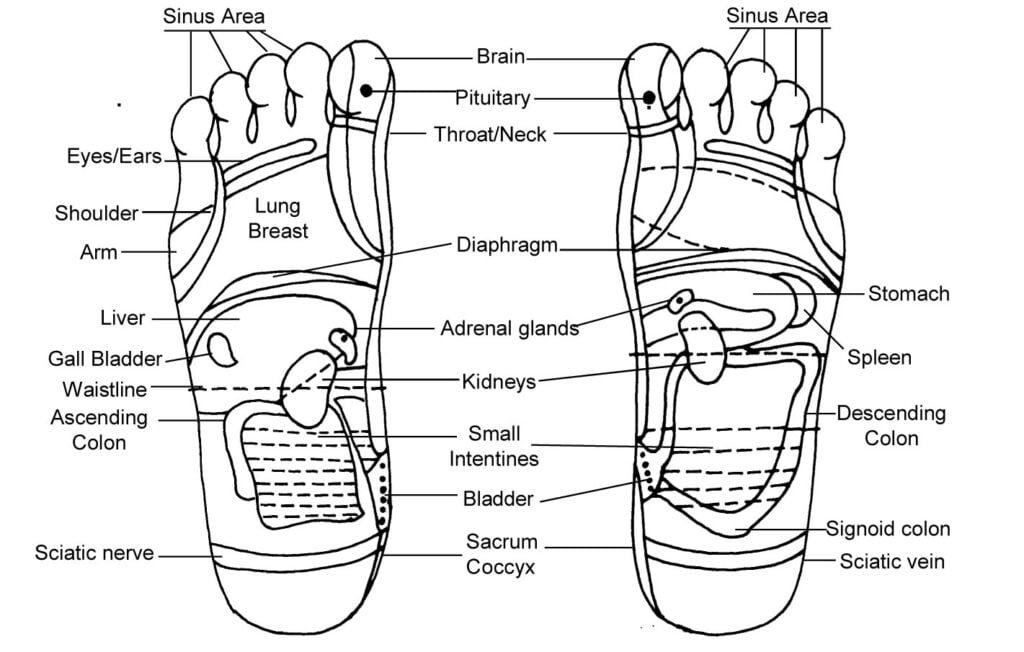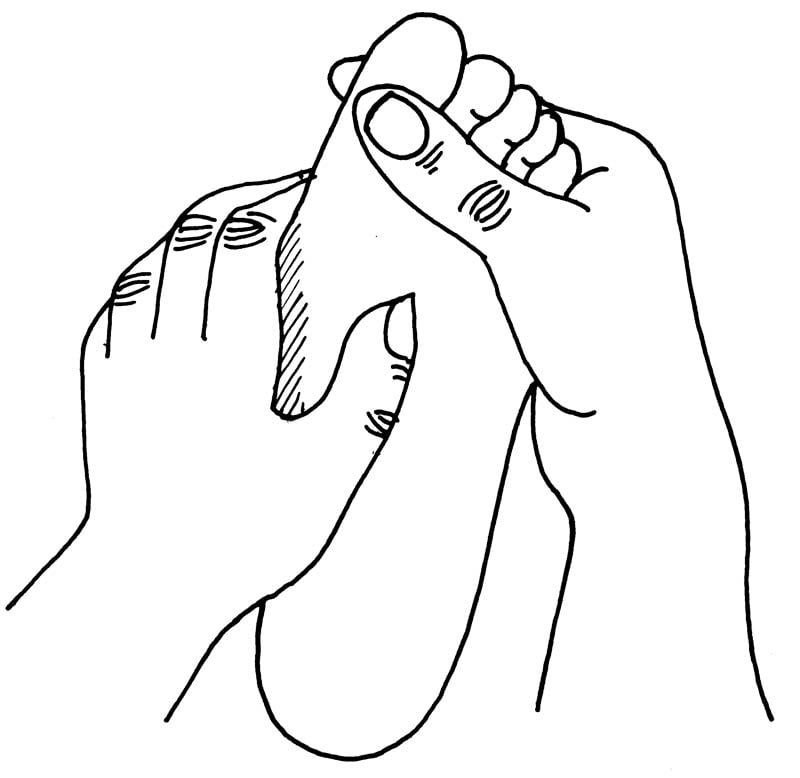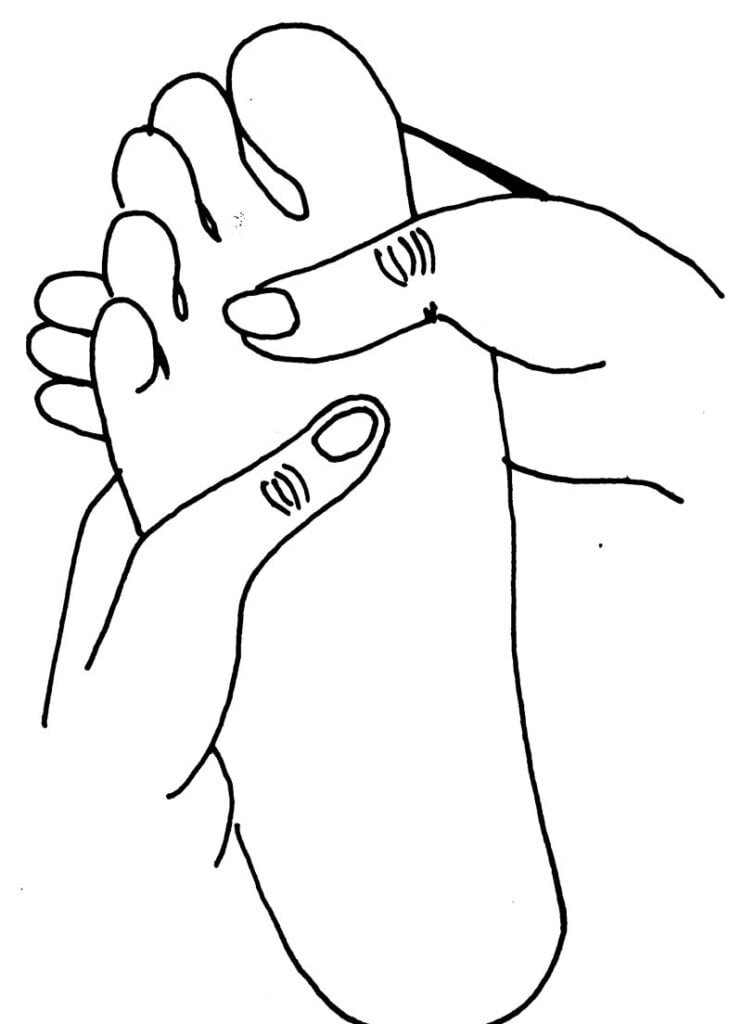For every complaint of the individual there is disturbed balance which can be found out on the relative reflex point on the feet and hands of a person.
Besides reflexology there are many other forms also using different techniques and methods but there lies a single common objective behind all the therapies that is to keep people healthy or to restore them to health. There are the details of foot reflexology.
Reflexology can be easily operated on with one or other forms of medicines for example acupuncture, homeopathy, hydrotherapy, herbal remedies, yoga etc. There are plenty of possible combination but all these different methods cannot be applied together. Too much stimulation from too many different directions can have a bad effect.

Before starting with the reflex treatment, it is important for a reflexologist to look at the condition of the feet. The feet can reveal a lot of factors which help to recognize some of the probable problem areas in the body at an early stage. If there is thick callous, thicker than normal at a certain place, it is possible to find out that on which reflex this rapid growth is taking and this reflex can be considered to be out of balance. When there are corns, it is important to find out on which reflex the corns are situated. The cause behind these lies some where inside the body.
There can be variations in the skin colours of the feet. The colour may differ from place to place on the foot. The bright red colour indicates too much of blood circulation through the corresponding reflexes, where as white skin is the indication of poor circulation. The purple colour skin points to the congestion in that area. Dry flakes of skin on the surface of a foot show that the corresponding area is lacking in energy and indicates a disruption in the flow of energy. Cracks of the skin on the heels or between the toes are also very common.
Any pigmentation mark on the point or pain on a particular point of the foot gives an indication of imbalance in the body corresponding to reflex area well in advance. Thus it is often possible to prevent the occurrence of many complaints.
Foot Care : It is essential to take good care of feet. To have feet free from problems it is important to wear well fitting shoes. Often one should walk bare foot as it stimulates the reflexes on the feet, thereby stimulating the energy flow in the whole body. Nails should be trimmed regularly. The feet must be cleaned and washed regularly and good foot cream should be applied to prevent the skin becoming dry.
Precautions to be taken during treatment
The treatment must be suspended if :
There is perspiration of hands. It often happens when a reflex zone is massaged which is prone to reaction at that moment. So it is advised to reduce the pressure while giving massage.
If there is perspiration over the entire body and a cold feeling starts in the limbs accompanied by chattering of the teeth. It is better to stop the treatment immediately. In such a condition, the patient should be covered with something warm and Solar Plexus reflex area, the Pituitary and the Heart reflex area should be pressed, the patient recovers quickly.
The treatment should be avoided if:
The patient is a pregnant lady (especially after the third month of pregnancy)
The patient is very week, seriously ill or taking regular medication for serious health problems like cancer, diabetes.
The patient is suffering from chronic heart diseases.
After effects of the treatment:
The patient is relaxed and rather feels sleepy.
Urination may increase and in case of bladder infection it can become more cloudy and smells pungent.
A great deal of removal of waste matter through the intestines.
Past diseases which were not totally cured can become active again after treatment.
But all these consequences disappear later on as the ailment is cured through regular treatment and body is tuned to normal health.
Types of pressure
Acupressure term deals with pressing the pressure points on the body hands and feet using hands. Though various techniques for giving pressure are being practised through out the world but there are few basic working techniques. The use of these techniques develop an efficient sensitivity and the ability to conserve the energy by minimizing the use of effort on part of therapist.
All these techniques can be used on both the feet and the hands. The amount of pressure exerted varies from individual to individual under treatment. For example, very gentle pressure should be given to frail and weak children and elderly people.
To work on with these techniques, it is equally important to hold the reflex areas properly.
It is also advised to practice these techniques first on one’s own hand before dealing with the patients.
Thumbing
Thumb pressure is far more precise and penetrating. It is used for working the points along the reflex areas and meridians points. Place your thumb pads on the points use your extended fingers for support and exert the pressure required. Before Thumbing make sure that nails are trimmed properly, preventing it being pressed in two points.
Thumb Walking
The aim of thumb walking technique is to exert a constant steady pressure. As the name suggests, the thumb walks gently over the surface of the skin. Though the entire hand participates in this technique but the first joint of the thumb is the only moving part. The only outer edge of the tip of thumb is in contact with foot or hand and tiny steps are taken and the whole of the reflex area is worked. Caution should be taken that only the first joint of the thumb is moved without any flexibility or strengthening. For this, nails of the thumb or fingers must be trimmed properly, preventing it being pressed into the foot while working on the thumb. While working with this technique, the other four fingers serve to support the hand as they mere act as buffers. After pressing the thumb on the reflex area, only the thumb is pulled back without losing the contact and in this way the thumb is moved on.
Finger Walking
This technique is used to work on the top and sides of the feet and back of the hands. In this technique used one, two or all four fingers is made depending on pressure points.
Four fingers walking is used to treat lymphatic systems, place the tips of all four fingers on the top of foot close to the little toe taking support of thumb on the sole of foot. Gently pressing and pulling back walk all four fingers together from the base of little toe up to the ankle. Begin again with same process for the next toe.
Two finger walking is often used to treat reflexes on the back of the hands. Hold the wrist of patient by your supporting hand. Place your index and middle finger on the lateral side of the patient’s hand with support of thumb on the palm. Starting at the little finger web walk down across the metacarpal bones at the back of hand up to the web between the thumb and index finger.
Finger walking helps to relieve tension in chest and lungs area, areas for lymph drainage and vocal chords which are located between the big toe and second toe at the top of the foot.
Pivoting or Reflex Rotation
In this technique the position of thumb is same as in walking of thumb but pressure is given by outer edge of thumb. Press the point slowly and gently, rotate on it, keeping the contact of thumb on pressure point. To stimulate the meridian points rotating direction is used in anticlockwise.
To sedate the meridian points rotating is used in clockwise direction.
Sliding
In this technique, the pressure is exerted through thumb. The hand or foot under treatment is grasped gently and thumb is pressed lightly into the foot or hand. Maintaining the steady pressure, the thumb slides for a very small distance (about half inch). It is then pulled back for half of the distance it has moved and is again slided. In this way the entire reflex area is covered. Sliding technique helps to break down crystal deposits. This technique is mostly used on the soles of the feet and the palms of the hand to treat spinal reflex points. This type pressure is avoided on the tops of the feet and back of hands as they are delicate and such a pressure could be painful.
Thumb Hooking
Place the outer corner of thumb on a reflex points or meridian point with thumb flat. Bend the thumb at the first joint to apply pressure, and pull back across the points. Other fingers are used for support and counter pressure to increase the pressure wrist can be raised.

Hooking is used to stimulate the meridian points that are too small for walking technique and for reflex areas such as pituitary point and the solar plexus.
Relaxing Techniques
Before treating a patient and after finishing the treatment it is essential to relax the patient who are under stress and to stimulate the energy flow. The relaxing technique generally follows an order as stated below :
The hands and feet are smoothed out by stretching the muscles. It is done by providing a kind of metatarsal padding by both the hands and moving them rapidly back and forth. Stretching of muscles helps in the freedom of movement of bones. Stretching of muscles is then followed by kneading which relaxes and stimulates the flow of energy. For kneading one hand is placed across the top of the foot and the other hand is made into a clenched fist and is placed flatly against the bottom of the foot directly opposite the first hand. The foot is then given both clock- wise and anticlockwise half rotation. This pressure can be given on hands also.
Then treating the feet, the fingers are placed on the top of the foot, thumb serves as a support on the sole. Tiny circular movements are given with the fingers on the top and side of the foot, and over the ankle bones. Then, starting from the ankle the fingers of both the hands are allowed to stroke gently on the top and sides of the foot in an upward movement. For the hands, this technique is started from the wrist in an upward movement towards the fingers.
Last of all the thumb is placed in the centre of the diaphragm/solar plexus reflex and fingers are laid comfortably on the top of the foot. As the pressure is exerted on this point, the patient is told to take a deep breath and to hold it each time , the pressure is given.
As the pressure is slowly relaxed the breathe should also be slowly released.
Wringling

Starting at the top of the feet near the toes wrap your hands around the sides of the foot, with the thumbs on the sole and fingers on the top of the foot. Gently twist your hand back and forth in a wringling action as you move down the foot towards ankle. To massage the hands, use the same action, with your hands in similar position as for the feet.
Kneading
Place your one hand across the top of the foot and place the clenched fist of the other hand on the sole of foot. Pressing both hands in to the feet, make circular movements with both hands over the entire foot.

To massage the hands, place one hand across the back of your patient’s hand, the clenched fist of your hand on the palm. Make circular movements with both your hands while applying pressure over the entire surface of the hand.
Stretching
The position of the hands should be like wringling action. Starting near the ankle, pull your hands up towards the toes. Repeat if for five-seven times.

For hands starting near the wrists and pull the hands towards fingers. Effect of this massage is to stretch the foot and hand.
Stroking
Using alternate hands, stroke the foot softly from ankles to the toes to smooth and relax the whole arch of each foot.

Dessert Stroke
Take the foot in both hands and slide the hands gently up and down. Dessert strokes are enjoyable and can be used throughout the treatment to soothe and relax. Always end the session with dessert strokes to rebalance the whole foot .

Solar Plexus Relaxation
Place both thumbs on the solar plexus point located in the centre of the foot where there is a little indentation while pressing, patient must be advised to take deep breath and to hold it. During releasing the pressure patient should release the breath. This process should be repeated several times.

This relaxation is a good for the patient who is very tense or nervous. It can also be worked on both feet simultaneously.
Ankle Rotation
Stabilize the ankle by holding the right foot in the left hand supporting the heel. Gently wrap the fingers of the working hand below the base of toes. Rotate the foot in a slight oval motion several times in one direction, then several times in other direction.
Toe Rotation

With thumb and fingers of the left hand, firmly hold the base of the any toe to rotate. Take your thumb and first two fingers of your right hand and place them over the toes to it’s base with a slight lift, rotate each toe first in one direction several times then in other direction. It is used to relax stiff neck and cervical spondylitis.
Limitations of Reflexology
All fulminating infections, pneumonia, tuberculosis, leprosy, serious disorders of the heart, kidney failure, meningitis, tumours, cancer etc.
Finally, Reflexology has no role to play in such purely mechanical disorders like congenital anomalies (viz. cleft palate, heart valvular defects), mature cataract, varicosed veins, hernia, big stones in gall bladder/urinary tract, prolapsed uterus, prolapsed rectum, a foreign body in eye/ear/nose, fracture, big abscesses, etc.
Similarly, Reflexology cannot help disorders arising from deficiencies of essential nutrients like proteins, vitamins and minerals.
In conclusion, it can be said that Reflex Zone Therapy is a non-medicinal, natural form of treatment that is extremely popular in all corners of the world. It is a boon to mankind because:
- It is extremely simple, even a small child can learn it. Therefore, it can be used as self-treatment.
- It is amazingly effective, sometimes producing almost miraculous results.
- It is absolutely safe unlike medicines (which produce untoward side effects).
- It is inexpensive since no medicines are required and you need not rush to doctor for trivial ailments.
- It can be used alone or in conjunction with conventional medicines.
- It can be used to preserve peak health, prevent diseases and slow down ageing process.
However, the reader should understand that Reflexology is no panacea. It is not a cure all’ and should not be considered an alternative to competent medical care. It is, in fact, a means of enabling the body to attain a perfect balance in all its functions. It arouses and activates the natural healing forces that have been suppressed and, therefore, rendered ineffective by disease forces.

